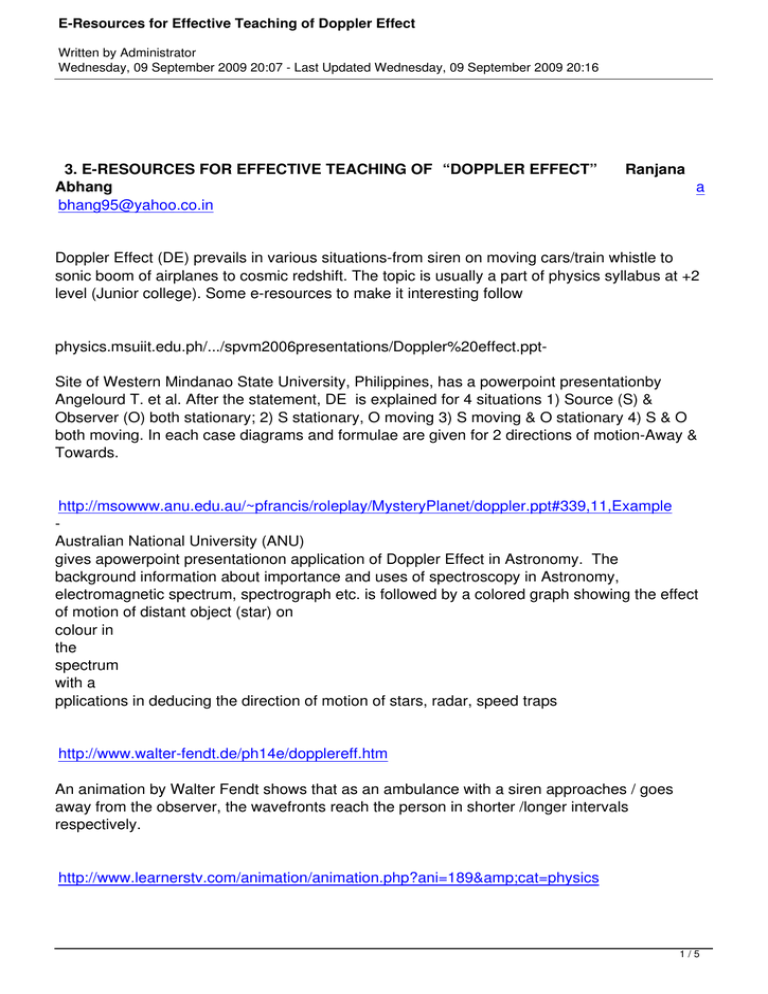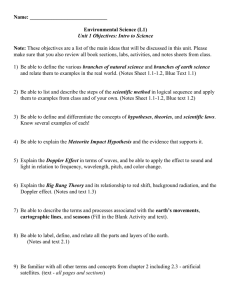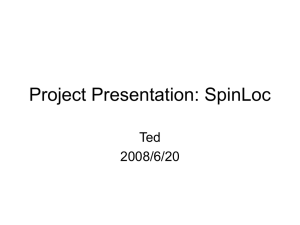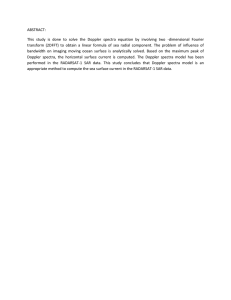E-Resources for Effective Teaching of Doppler Effect
advertisement

E-Resources for Effective Teaching of Doppler Effect Written by Administrator Wednesday, 09 September 2009 20:07 - Last Updated Wednesday, 09 September 2009 20:16 3. E-RESOURCES FOR EFFECTIVE TEACHING OF “DOPPLER EFFECT” Abhang bhang95@yahoo.co.in Ranjana a Doppler Effect (DE) prevails in various situations-from siren on moving cars/train whistle to sonic boom of airplanes to cosmic redshift. The topic is usually a part of physics syllabus at +2 level (Junior college). Some e-resources to make it interesting follow physics.msuiit.edu.ph/.../spvm2006presentations/Doppler%20effect.pptSite of Western Mindanao State University, Philippines, has a powerpoint presentationby Angelourd T. et al. After the statement, DE is explained for 4 situations 1) Source (S) & Observer (O) both stationary; 2) S stationary, O moving 3) S moving & O stationary 4) S & O both moving. In each case diagrams and formulae are given for 2 directions of motion-Away & Towards. http://msowww.anu.edu.au/~pfrancis/roleplay/MysteryPlanet/doppler.ppt#339,11,Example Australian National University (ANU) gives apowerpoint presentationon application of Doppler Effect in Astronomy. The background information about importance and uses of spectroscopy in Astronomy, electromagnetic spectrum, spectrograph etc. is followed by a colored graph showing the effect of motion of distant object (star) on colour in the spectrum with a pplications in deducing the direction of motion of stars, radar, speed traps http://www.walter-fendt.de/ph14e/dopplereff.htm An animation by Walter Fendt shows that as an ambulance with a siren approaches / goes away from the observer, the wavefronts reach the person in shorter /longer intervals respectively. http://www.learnerstv.com/animation/animation.php?ani=189&amp;cat=physics 1/5 E-Resources for Effective Teaching of Doppler Effect Written by Administrator Wednesday, 09 September 2009 20:07 - Last Updated Wednesday, 09 September 2009 20:16 Learners TV site shows animation by D.M.Harrison (2007). Wave fronts of a moving source depend upon observer’s position & change as speed of source is varied- speed of wave is constant http://www.learnerstv.com/animation/animation.php?ani=190&amp;cat=physics Learners TV site shows a series of 8 animated scenes by D.M.Harrison (2003): DE for moving sound source (car); Process of hearing sound; Graphs of Source (Tuning fork) amplitude & Detector (ear drum) response versus sound pressure for different cases: Source stationary and detector moving towards & away, with velocity <= sound; Detector stationary and source moving; Formulae relating source & detector frequencies covering above cases http://galileoandeinstein.physics.virginia.edu/more_stuff/flashlets/doppler.htm University of Virginia site displays a flashlet by M. Fowler. A moving source emits circular waves. The speed of source can be changed & ratio of speed of source to the speed of wave, (i.e. the Mach number) is controlled by a slider giving shockwave for Mach number>1. The changes are seen in the picture of wavefronts as well as in sound heard using microphone. http://galileo.phys.virginia.edu/classes/152.mf1i.spring02/DopplerEffect.htm Notes by M. Fowler (2008) for above flashlet contain derivations of formulae for various combinations of motions of sound source & observer, relativistic equation for Doppler shift using light. http://www.lon-capa.org/~mmp/applist/doppler/d.htm Site Ion-capa has Java applet by W. Bauer (1999) for DE visualization. By dragging the mouse, source velocity (represented by arrow) is changed. Exact value of Mach number is displayed numerically. http://www.gly.uga.edu/railsback/Doppler/Doppler01a.html University of Geogia (UGA)- Difference in pitch (sound)/ colour (light) to 2 observers on 2 sides of a moving source. http://www.astro.ubc.ca/~scharein/a311/Sim.html#Doppler University of British Columbia, Canada, displays an interactive java simulation with instructions for its working. By clicking on “Run Animation” button, waves are started. Source motion can be disabled (ie. stationary) or enabled to be linear / circular / bounce motion; Source speed can be changed as faster/slower/ reverse/ mach; Sound speed can be decreased /increased. 2/5 E-Resources for Effective Teaching of Doppler Effect Written by Administrator Wednesday, 09 September 2009 20:07 - Last Updated Wednesday, 09 September 2009 20:16 http://paws.kettering.edu/~drussell/Demos/doppler/doppler.html Kettering University site shows an animation by D. A. Russell, for stationary observer and moving source. Wave fronts for three cases are illustrated: V source <V sound , V source =V sound , V source >V sound (with Mach cone and sonic boom created by supersonic jet trainer braking sound barrier)Frequencyshift formula, Mach no. & explanation for each case, links for applications of DE e.g. Doppler Radar, Echocardiography, Radio Direction Finding System are given. http://www.astro.illinois.edu/projects/data/Doppler/index.html DATA Site of University of Illinois, illustrates the concepts of Red and Blue Shifts by color of light waves. Intermediate steps of change in velocity of the source are followed by gradual change in frequency and colour of waves. Formula for wavelength change for light is given. http://www.netzmedien.de/dopplereffect/index.htmlA simulation by S. Maus & D. Roth (2002). Change in source frequency moving with constant velocity depends on observer’s position. By moving the mouse, mouse position, elapsed time t and wave period T are displayed on a graph paper. This Applet is &quot;scriptable&quot; i.e. it can be configured and controlled by using JavaScript methodse.g. Wave phase velocity, emitter velocity relative to wave phase velocity, wave period and time step for numerical calculation can be varied http://www.youtube.com 3/5 E-Resources for Effective Teaching of Doppler Effect Written by Administrator Wednesday, 09 September 2009 20:07 - Last Updated Wednesday, 09 September 2009 20:16 site of You Tube presents a variety of videos with commentary. Special points of some are cited below. Time duration (minutes seconds) given in bracket http://www.youtube.com/watch?v=a3RfULw7aAY&amp;NR=1 “DE using Car Horn” (9”) & http://www.youtube.com/watch?v=imoxDcn2Sgo “DE-Fire Engine siren” (18”) by David Robert- changes in sound pitch with direction of moving sources (away/towards observer) http://www.youtube.com/watch?v=4mUjM1qMaa8 “DE- Listener in Motion” by Pelletier Physics (25”)-changes in pitch as listener moves towards / away from a stationary source http://www.youtube.com/watch?v=RsiY8VdDlDQ “DE-3D Animation” by Paulie(4’:42”) Basic relations between pitch, frequency & wavelength; Applications e.g. Doppler Radar http://www.youtube.com/watch?v=-t63xYSgmKE “SLight” (2’:33”) DE for Sound (Car) and Light (Star) both- sources receding / approaching observers : change in pitch & colour http://www.youtube.com/watch?v=n4BHA1hHjDc&amp;feature=related “Red and Blue shifts of light” (12”) seen by an observer in receding /approaching parts of a rotating galaxy. http://www.youtube.com/watch?v=FhfnqboacV0 “What is Redshift”-Tom Jarrett of IPAC Caltech (2’:30”): Use of DE to measure distances of stars in the expanding universe. http://www.youtube.com/watch?v=Man9ulEYSgk –“Red Shift” by fizzics organization (2’)-Examples of water, sound & light waves, cosmic red shift in spectra, Big bang theory http://journal.lapen.org.mx/jan08/LAJPE-125Final%20Gimenez.pdf site has an article by Marcos H. Giménez et al (2008) in Latin American Journal on Physics Education showing animation process of the space-time visualization explains DE, Sound barrier etc. 4/5 E-Resources for Effective Teaching of Doppler Effect Written by Administrator Wednesday, 09 September 2009 20:07 - Last Updated Wednesday, 09 September 2009 20:16 Thus e-resources bring life and interactivity to the concepts and enhance understanding. 5/5


